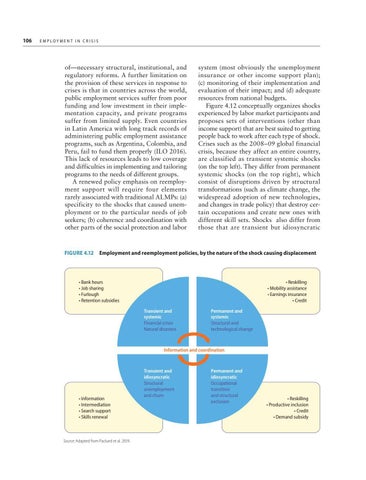106 E m p l o y m e n t
in Crisis
of—necessary structural, institutional, and regulatory reforms. A further limitation on the provision of these services in response to crises is that in countries across the world, public employment services suffer from poor funding and low investment in their implementation capacity, and private programs suffer from limited supply. Even countries in Latin America with long track records of administering public employment assistance programs, such as Argentina, Colombia, and Peru, fail to fund them properly (ILO 2016). This lack of resources leads to low coverage and difficulties in implementing and tailoring programs to the needs of different groups. A renewed policy emphasis on reemployment support will require four elements rarely associated with traditional ALMPs: (a) specificity to the shocks that caused unemployment or to the particular needs of job seekers; (b) coherence and coordination with other parts of the social protection and labor
system (most obviously the unemployment insurance or other income support plan); (c) monitoring of their implementation and evaluation of their impact; and (d) adequate resources from national budgets. Figure 4.12 conceptually organizes shocks experienced by labor market participants and proposes sets of interventions (other than income support) that are best suited to getting people back to work after each type of shock. Crises such as the 2008–09 global financial crisis, because they affect an entire country, are classified as transient systemic shocks (on the top left). They differ from permanent systemic shocks (on the top right), which consist of disruptions driven by structural transformations (such as climate change, the widespread adoption of new technologies, and changes in trade policy) that destroy certain occupations and create new ones with different skill sets. Shocks also differ from those that are transient but idiosyncratic
FIGURE 4.12 Employment and reemployment policies, by the nature of the shock causing displacement
• Bank hours • Job sharing • Furlough • Retention subsidies
• Reskilling • Mobility assistance • Earnings insurance • Credit Transient and systemic Financial crises Natural disasters
Permanent and systemic Structural and technological change
Information and coordination
• Information • Intermediation • Search support • Skills renewal
Source: Adapted from Packard et al. 2019.
Transient and idiosyncratic Structural unemployment and churn
Permanent and idiosyncratic Occupational transition and structural exclusion
• Reskilling • Productive inclusion • Credit • Demand subsidy

